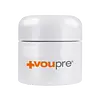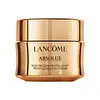What's inside
What's inside
 Key Ingredients
Key Ingredients

 Benefits
Benefits

 Concerns
Concerns

 Ingredients Side-by-side
Ingredients Side-by-side

Water
Skin ConditioningHydrogenated Polyisobutene
EmollientCyclopentasiloxane
EmollientCyclohexasiloxane
EmollientStearic Acid
CleansingPEG-100 Stearate
Cetearyl Alcohol
EmollientCaprylic/Capric Triglyceride
MaskingGlycerin
HumectantButylene Glycol
HumectantGlyceryl Stearate
EmollientCera Alba
EmollientPichia/Resveratrol Ferment Extract
Skin ConditioningTetrahexyldecyl Ascorbate
AntioxidantCaffeine
Skin ConditioningRetinyl Palmitate
Skin ConditioningTocopheryl Acetate
AntioxidantCollagen
MoisturisingChitosan
Allantoin
Skin ConditioningPolyacrylamide
C13-14 Isoparaffin
EmollientLaureth-7
EmulsifyingMyristic Acid
CleansingCarbomer
Emulsion StabilisingBenzyl Alcohol
PerfumingMica
Cosmetic ColorantTitanium Dioxide
Cosmetic ColorantTin Oxide
AbrasiveTriethanolamine
BufferingPhenoxyethanol
PreservativeEthylhexylglycerin
Skin ConditioningCI 77491
Cosmetic ColorantWater, Hydrogenated Polyisobutene, Cyclopentasiloxane, Cyclohexasiloxane, Stearic Acid, PEG-100 Stearate, Cetearyl Alcohol, Caprylic/Capric Triglyceride, Glycerin, Butylene Glycol, Glyceryl Stearate, Cera Alba, Pichia/Resveratrol Ferment Extract, Tetrahexyldecyl Ascorbate, Caffeine, Retinyl Palmitate, Tocopheryl Acetate, Collagen, Chitosan, Allantoin, Polyacrylamide, C13-14 Isoparaffin, Laureth-7, Myristic Acid, Carbomer, Benzyl Alcohol, Mica, Titanium Dioxide, Tin Oxide, Triethanolamine, Phenoxyethanol, Ethylhexylglycerin, CI 77491
Water
Skin ConditioningGlycerin
HumectantCyclohexasiloxane
EmollientButylene Glycol
HumectantAlcohol Denat.
AntimicrobialButyrospermum Parkii Butter
Skin ConditioningStearic Acid
CleansingStearyl Alcohol
EmollientCetyl Alcohol
EmollientPalmitic Acid
EmollientPEG-100 Stearate
Glyceryl Stearate
EmollientCera Alba
EmollientSodium Stearoyl Glutamate
CleansingOctyldodecanol
EmollientCI 77891
Cosmetic ColorantCI 19140
Cosmetic ColorantCI 16035
Cosmetic ColorantZea Mays Oil
EmulsifyingMica
Cosmetic ColorantTocopheryl Acetate
AntioxidantEscin
TonicTocopherol
AntioxidantAscorbyl Palmitate
AntioxidantHydroxypropyl Tetrahydropyrantriol
Skin ConditioningHydrolyzed Linseed Extract
Skin ConditioningSodium Benzoate
MaskingPhenoxyethanol
PreservativeAdenosine
Skin ConditioningPEG-20 Stearate
EmulsifyingTrisodium Ethylenediamine Disuccinate
Polysorbate 80
EmulsifyingChlorhexidine Digluconate
AntimicrobialPanthenol
Skin ConditioningPentaerythrityl Tetra-Di-T-Butyl Hydroxyhydrocinnamate
AntioxidantTin Oxide
AbrasivePropanediol
SolventPropylene Glycol
HumectantIsohexadecane
EmollientCapryloyl Salicylic Acid
ExfoliatingAcrylamide/Sodium Acryloyldimethyltaurate Copolymer
Emulsion StabilisingMyristic Acid
CleansingSorbitan Oleate
EmulsifyingGeraniol
PerfumingPassiflora Edulis Seed Oil
EmollientRose Extract
Skin ConditioningRosa Damascena Flower Oil
MaskingRosa Centifolia Flower Extract
AstringentTetrasodium Glutamate Diacetate
Citronellol
PerfumingCitric Acid
BufferingPrunus Armeniaca Kernel Oil
MaskingOryza Sativa Bran Oil
EmollientParfum
MaskingWater, Glycerin, Cyclohexasiloxane, Butylene Glycol, Alcohol Denat., Butyrospermum Parkii Butter, Stearic Acid, Stearyl Alcohol, Cetyl Alcohol, Palmitic Acid, PEG-100 Stearate, Glyceryl Stearate, Cera Alba, Sodium Stearoyl Glutamate, Octyldodecanol, CI 77891, CI 19140, CI 16035, Zea Mays Oil, Mica, Tocopheryl Acetate, Escin, Tocopherol, Ascorbyl Palmitate, Hydroxypropyl Tetrahydropyrantriol, Hydrolyzed Linseed Extract, Sodium Benzoate, Phenoxyethanol, Adenosine, PEG-20 Stearate, Trisodium Ethylenediamine Disuccinate, Polysorbate 80, Chlorhexidine Digluconate, Panthenol, Pentaerythrityl Tetra-Di-T-Butyl Hydroxyhydrocinnamate, Tin Oxide, Propanediol, Propylene Glycol, Isohexadecane, Capryloyl Salicylic Acid, Acrylamide/Sodium Acryloyldimethyltaurate Copolymer, Myristic Acid, Sorbitan Oleate, Geraniol, Passiflora Edulis Seed Oil, Rose Extract, Rosa Damascena Flower Oil, Rosa Centifolia Flower Extract, Tetrasodium Glutamate Diacetate, Citronellol, Citric Acid, Prunus Armeniaca Kernel Oil, Oryza Sativa Bran Oil, Parfum
Ingredients Explained
These ingredients are found in both products.
Ingredients higher up in an ingredient list are typically present in a larger amount.
Butylene Glycol (or BG) is used within cosmetic products for a few different reasons:
Overall, Butylene Glycol is a safe and well-rounded ingredient that works well with other ingredients.
Though this ingredient works well with most skin types, some people with sensitive skin may experience a reaction such as allergic rashes, closed comedones, or itchiness.
Learn more about Butylene GlycolCera alba is beeswax, or the wax used by bees to make honeycombs. It is a texture-enhancer and emollient. A study from 2003 found beeswax to be a stronger emollient than ingredients such as petroleum jelly.
As an emollient, beeswax helps hydrate the skin by creating a barrier on top. This barrier traps moisture in.
Emulsifiers help prevent ingredients from separating. This helps create consistent texture.
The structure of beeswax is mainly long-chain alcohols and the esters of fatty acids.
There are three types of beeswax: yellow, white, and absolute. Yellow is pure beeswax taken from the honeycomb. White beeswax is created by filtering or bleaching yellow beeswax. Absolute beeswax is created by treating beeswax with alcohol. Beeswax used in cosmetics are purified.
Beeswax has been used throughout history and even in prehistoric times. Some common uses for beeswax still used today are making candles, as a waterproofing agent, and polish for leather.
Learn more about Cera AlbaCyclohexasiloxane is a type of silicone more commonly known as D6. It is an emollient and solvent.
Cyclohexasiloxane is used to evenly distribute ingredients throughout the product. When applied to the skin, Cyclohexasiloxane evaporates and leaves behind a silky feel.
As an emollient, it can help the skin feel soft and hydrated. It is also used to reduce frizz in hair products.
Learn more about CyclohexasiloxaneGlycerin is already naturally found in your skin. It helps moisturize and protect your skin.
A study from 2016 found glycerin to be more effective as a humectant than AHAs and hyaluronic acid.
As a humectant, it helps the skin stay hydrated by pulling moisture to your skin. The low molecular weight of glycerin allows it to pull moisture into the deeper layers of your skin.
Hydrated skin improves your skin barrier; Your skin barrier helps protect against irritants and bacteria.
Glycerin has also been found to have antimicrobial and antiviral properties. Due to these properties, glycerin is often used in wound and burn treatments.
In cosmetics, glycerin is usually derived from plants such as soybean or palm. However, it can also be sourced from animals, such as tallow or animal fat.
This ingredient is organic, colorless, odorless, and non-toxic.
Glycerin is the name for this ingredient in American English. British English uses Glycerol/Glycerine.
Learn more about GlycerinGlyceryl Stearate is a mix of glycerin and stearic acid.
It is used to stabilize the mixing of water and oil ingredients. By preventing these ingredients from separating, it can help elongate shelf life. It can also help thicken the product's texture.
As an emollient, it helps soften skin and supports barrier-replenishing ingredients.
In cosmetics, Glyceryl Stearate is often made from vegetable oils or synthetically produced.
This ingredient may not be fungal-acne safe
Fun fact: The human body also creates Glyceryl Stearate naturally.
Learn more about Glyceryl StearateMica is a naturally occurring mineral used to add shimmer and color in cosmetics. It can also help improve the texture of a product or give it an opaque, white/silver color.
Serecite is the name for very fine but ragged grains of mica.
This ingredient is often coated with metal oxides like titanium dioxide. Trace amounts of heavy metals may be found in mica, but these metals are not harmful in our personal products.
Mica has been used since prehistoric times throughout the world. Ancient Egyptian, Indian, Greek, Roman, Aztec, and Chinese civilizations have used mica.
Learn more about MicaMyristic Acid is a saturated fatty acid. It is naturally found in milk fat. Other sources include palm oil, coconut oil, and butter fat.
Myristic Acid is an emulsifer and cleanser. As an emulsifer, it stabilizes a product by preventing ingredients from separating. Myristic Acid helps clean your skin by acting as a surfactant. It tends to gather oil and dirt on your skin to be easily rinsed away.
One study from 2021 found Myristic Acid to have anti-inflammatory properties.
Learn more about Myristic AcidPeg-100 Stearate is an emollient and emulsifier. As an emollient, it helps keep skin soft by trapping moisture in. On the other hand, emulsifiers help prevent oil and water from separating in a product.
PEGS are a hydrophilic polyether compound . There are 100 ethylene oxide monomers in Peg-100 Stearate. Peg-100 Stearate is polyethylene glycol ester of stearic acid.
Phenoxyethanol is a preservative that has germicide, antimicrobial, and aromatic properties. Studies show that phenoxyethanol can prevent microbial growth. By itself, it has a scent that is similar to that of a rose.
It's often used in formulations along with Caprylyl Glycol to preserve the shelf life of products.
Stearic Acid is a fatty acid. It is an emollient, emulsifier, and texture enhancer.
As an emollient, stearic acid helps soften skin. It aids the skin's protective barrier by preventing water loss. It also provides a gentle cleansing effect without stripping away natural oils.
Stearic acid may also be used to enhance the texture of products. It can add volume and stabilize ingredients such as water and oil. This can help water and oil ingredients from separating.
Sources of stearic acid include animal or vegetable fats/oils such as coconut or shea. It can be naturally found in butter, cocoa butter, shea butter, vegetable fats, and animal tallow.
This ingredient may not be Malassezia folliculitis, or fungal-acne safe.
Learn more about Stearic AcidTin Oxide is an inorganic oxide used to add opacity and volume to a product. In nature, it is already found in mineral form. The main ore of tin is an opaque and shiny mineral called casseterite.
Tin Oxide helps remove translucency in a product, or make it more opaque. Besides adding opacity, tin oxide is used for bulking to add volume.
Tocopheryl Acetate is AKA Vitamin E. It is an antioxidant and protects your skin from free radicals. Free radicals damage the skin by breaking down collagen.
One study found using Tocopheryl Acetate with Vitamin C decreased the number of sunburned cells.
Tocopheryl Acetate is commonly found in both skincare and dietary supplements.
Learn more about Tocopheryl AcetateWater. It's the most common cosmetic ingredient of all. You'll usually see it at the top of ingredient lists, meaning that it makes up the largest part of the product.
So why is it so popular? Water most often acts as a solvent - this means that it helps dissolve other ingredients into the formulation.
You'll also recognize water as that liquid we all need to stay alive. If you see this, drink a glass of water. Stay hydrated!
Learn more about Water